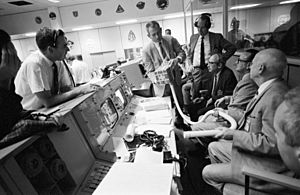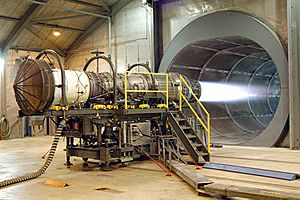Aerospace engineering facts for kids

NASA engineers, seen here in mission control during Apollo 13, worked diligently to protect the lives of the astronauts on the mission.
|
|
| Occupation | |
|---|---|
| Names | Aerospace engineer Engineer |
| Profession | |
|
Activity sectors
|
Aeronautics, astronautics, science |
| Description | |
| Competencies | Technical knowledge, management skills (see also glossary of aerospace engineering) |
|
Education required
|
Bachelor's Degree |
|
Fields of
employment |
Technology, science, space exploration, military |
Aerospace engineering is the primary field of engineering concerned with the development of aircraft and spacecraft. It has two major and overlapping branches: aeronautical engineering and astronautical engineering. Avionics engineering is similar, but deals with the electronics side of aerospace engineering.
"Aeronautical engineering" was the original term for the field. As flight technology advanced to include vehicles operating in outer space, the broader term "aerospace engineering" has come into use. Aerospace engineering, particularly the astronautics branch, is often colloquially referred to as "rocket science".
Contents
Overview
Flight vehicles are subjected to demanding conditions such as those caused by changes in atmospheric pressure and temperature, with structural loads applied upon vehicle components. Consequently, they are usually the products of various technological and engineering disciplines including aerodynamics, propulsion, avionics, materials science, structural analysis and manufacturing. The interaction between these technologies is known as aerospace engineering. Because of the complexity and number of disciplines involved, aerospace engineering is carried out by teams of engineers, each having their own specialized area of expertise.
Elements


Some of the elements of aerospace engineering are:
- Radar cross-section – the study of vehicle signature apparent to remote sensing by radar.
- Fluid mechanics – the study of fluid flow around objects. Specifically aerodynamics concerning the flow of air over bodies such as wings or through objects such as wind tunnels (see also lift and aeronautics).
- Astrodynamics – the study of orbital mechanics including prediction of orbital elements when given a select few variables. While few schools in the United States teach this at the undergraduate level, several have graduate programs covering this topic (usually in conjunction with the Physics department of said college or university).
- Statics and Dynamics (engineering mechanics) – the study of movement, forces, moments in mechanical systems.
- Mathematics – in particular, calculus, differential equations, and linear algebra.
- Electrotechnology – the study of electronics within engineering.
- Propulsion – the energy to move a vehicle through the air (or in outer space) is provided by internal combustion engines, jet engines and turbomachinery, or rockets (see also propeller and spacecraft propulsion). A more recent addition to this module is electric propulsion and ion propulsion.
- Control engineering – the study of mathematical modeling of the dynamic behavior of systems and designing them, usually using feedback signals, so that their dynamic behavior is desirable (stable, without large excursions, with minimum error). This applies to the dynamic behavior of aircraft, spacecraft, propulsion systems, and subsystems that exist on aerospace vehicles.
- Aircraft structures – design of the physical configuration of the craft to withstand the forces encountered during flight. Aerospace engineering aims to keep structures lightweight and low-cost while maintaining structural integrity.
- Materials science – related to structures, aerospace engineering also studies the materials of which the aerospace structures are to be built. New materials with very specific properties are invented, or existing ones are modified to improve their performance.
- Solid mechanics – Closely related to material science is solid mechanics which deals with stress and strain analysis of the components of the vehicle. Nowadays there are several Finite Element programs such as MSC Patran/Nastran which aid engineers in the analytical process.
- Aeroelasticity – the interaction of aerodynamic forces and structural flexibility, potentially causing flutter, divergence, etc.
- Avionics – the design and programming of computer systems on board an aircraft or spacecraft and the simulation of systems.
- Software – the specification, design, development, test, and implementation of computer software for aerospace applications, including flight software, ground control software, test & evaluation software, etc.
- Risk and reliability – the study of risk and reliability assessment techniques and the mathematics involved in the quantitative methods.
- Noise control – the study of the mechanics of sound transfer.
- Aeroacoustics – the study of noise generation via either turbulent fluid motion or aerodynamic forces interacting with surfaces.
- Flight testing – designing and executing flight test programs in order to gather and analyze performance and handling qualities data in order to determine if an aircraft meets its design and performance goals and certification requirements.
Images for kids
-
Orville and Wilbur Wright flew the Wright Flyer in 1903 at Kitty Hawk, North Carolina.
See also
 In Spanish: Ingeniería aeroespacial para niños
In Spanish: Ingeniería aeroespacial para niños




